Modeling Effects of Climate Change and Fire Management on Western White Pine (Pinus monticola) in the Northern Rocky Mountains, USA
Abstract
: Climate change is projected to profoundly influence vegetation patterns and community compositions, either directly through increased species mortality and shifts in species distributions or indirectly through disturbance dynamics such as increased wildfire activity and extent, shifting fire regimes, and pathogenesis. Mountainous landscapes have been shown to be particularly sensitive to climate changes and are likely to experience significant impacts under predicted future climate regimes. Western white pine (Pinus monticola), a five-needle pine species that forms the most diverse of the white pine forest cover types in the western United States, is vulnerable to an interacting suite of threats that includes climate change, fire suppression, white pine blister rust (Cronartium ribicola), and mountain pine beetles (Dendroctonus ponderosae) that have already caused major changes in species distribution and abundance. We used the mechanistic simulation model FireBGCv2 to simulate effects of climate change and fire management on western white pines in a mountainous watershed in Glacier National Park, Montana, USA. Our results suggest that warming temperatures favor increased abundance of western white pine over existing climax and shade tolerant species in the study area, mainly because warmer conditions potentiate fire dynamics, including increased wildfire frequency and extent, which facilitates regeneration. Suppression of wildfires reduced the area dominated by western white pine, but fire suppression was less effective at limiting burned area extent and fire frequency in a warmer and drier climate. Wildfires created canopy gaps that allowed for western white pine regeneration at a high enough rate to escape local extirpation from white pine blister rust. Western white pine appears to be a resilient species even under fairly extreme warming trajectories and shifting fire regimes, and may provide a hedge against vegetation community shifts away from forest types and toward grass and shrublands.1. Introduction
Climate change is projected to profoundly influence landscape patterns and biotic community compositions either directly through increased species mortality and shifts in species distributions, or indirectly through processes such as increased wildfire activity and extent, shifting fire regimes, and pathogenesis [1-5]. Forests of the western United States are expected to experience significant impacts in response to projected future climate change, particularly in mountainous ecosystems [6]. Comparison of climate projections with plant-climate profiles for the region suggests that by the end of the 21st century approximately 47 percent of the landscape may experience climate conditions outside of the current analog, resulting in an increase in montane forest and grassland communities at the expense of subalpine, alpine, and tundra ecosystem types [7]. Recent research shows that background tree mortality rates in the western United States have increased rapidly in recent decades, likely as the result of regional warming and increased water stress [8]. Widespread tree mortality, species range shifts, and changes in disturbance regimes have potentially severe negative consequences for biodiversity, wildlife habitat, snowpack accumulation and retention, timing and amount of surface water runoff, and carbon sequestration [6,9]. Climate-mediated shifts in terrestrial ecosystems are occurring in the context of other long-term anthropogenic influences such as land use change, resource development, and forest management. These interactions may further serve to shift ecosystems away from current conditions [5].
We developed a simulation modeling experiment using the mechanistic ecosystem process model FireBGCv2 [10] to assess the effects of climate changes and fire management on a mountainous, forested landscape in the northern Rocky Mountains, USA. We focused on dynamics of western white pine (Pinus monticola), a five-needle white pine species that, prior to the 20th century, was a major component in forested ecosystems of the inland northwest United States but has been greatly reduced in distribution and abundance by a complex set of interacting disturbances—climate change, white pine blister rust (Cronartium ribicola), mountain pine beetles (Dendroctonus ponderosae), and anthropogenic fire exclusion [9]. Wildfires facilitate regeneration of western white pine forests by creating canopy openings that allow seedlings to establish competitively over associated late-seral species such as western red cedar (Thuja plicata), western hemlock (Tsuga heterophylla), and grand fir (Abies grandis). These climax species are highly susceptible to mortality from insects, root diseases, and wildfire; thus, disturbance events would historically have led to ongoing initiation of western white pine forests. This successional pattern once formed the basis for a resilient, shifting mosaic of long-lived tree communities in both montane and subalpine habitats of the inland northwest [9].
We hypothesized that (1) warming temperatures would result in more frequent fires and larger annual burned extent over baseline conditions, favoring western white pines over less fire-adapted montane tree species; (2) reduced levels of fire suppression would increase the abundance of western white pines across the simulation landscape; and (3) warming temperatures would shift western white pine communities to higher elevation sites as the result of upslope shifts in temperature isotherms. Warming temperatures are expected to alter fire regimes, potentially catalyzing profound shifts in vegetation composition [4,11,12]. Fire suppression, widely used in Rocky Mountain ecosystems to limit fire damage to human populations, property and perceived negative influences on vegetation, has degraded fire-prone forests, changed forest structure and successional patterns, and reduced heterogeneity across broad spatial scales [13]. Upward and latitudinal migration of high-elevation forests has been previously noted in response to long-term climate trends [14,15]. Temperature-mediated species range shifts may be further complicated by altered fire regimes [16-19]. For example, warmer temperatures and altered moisture patterns affect fuel availability (vegetation) and fuel moisture, thereby increasing fire frequencies in high-elevation forests that historically experienced stand-replacement wildfires at long fire return intervals.
Climate, vegetation, and disturbance interactions are complex and do not operate independently. Simulation modeling provides a useful mechanism for assessing these complex and interacting dynamics and incorporating uncertainty associated with global climate model projections, particularly in ecosystems where primary productivity is constrained by water and/or temperature limitations [20,21] and variation in these climate drivers is likely to result in differences in vegetation species distributions. Climate projections for the next 20–100 years are consistent in their assessment of warming temperatures over the western United States, in most cases outside the estimated natural variability [22], although the magnitude of temperature increase varies by emissions scenario and general circulation model (GCM) [23].
Increases in fire frequency and burned area extent are projected under warming future climates [3,24,25]. These conditions may provide a suitable environmental context for persistence of fire-adapted tree species like western white pine, particularly if shifts in temperature and precipitation constrain white pine blister rust infections that currently limit the abundance of the species [26-28]. The objectives of our study were to assess whether western white pine, as a disturbance-adapted and disturbance-dependent species, might be both resistant and resilient to changing environmental conditions, thus serving as an important forest component in future climates.
2. Western White Pine Communities
2.1. Ecology
Western white pine is a North American pine species (genus Pinus subgenus Strobus) that is widely distributed across the interior west over 17° of latitude and 13° of longitude, from mesic to xeric environments across a range of slopes, aspects, elevations, and soil types [9] (Figure 1). Western white pine is a dominant seral species in mesic, montane forest ecosystems in northern Idaho and adjacent areas of Montana, Washington, and British Columbia (inland northwest); and is a minor but widespread seral component of drier forests in southern Oregon and subalpine habitats at the southern end of its distribution in the Sierra Nevada mountains of California [9,29] (Figure 2). Climate patterns in those areas where the species occurs most abundantly include short, warm summer seasons of low precipitation and cold winters with heavy snowfall, and climatic controls over distribution are lower-elevation moisture deficits and upper-elevation temperature deficits that limit both germination and survival of seedlings [30].
Western white pine is a fire-dependent, fire-adapted species in that its regeneration is facilitated by periodic disturbance events such as wildfires that create canopy gaps and allow for competitive seedling establishment over shade-tolerant species [9]. The species is considered to be moderately fire resistant as the result of relatively thick bark, inflammable foliage, and high crown base [33,34]. Western white pines in Glacier National Park occur predominantly within the cedar/hemlock zone together with other pioneer species such as Douglas-fir (Pseudotsuga menziesii), lodgepole pine (Pinus contorta), and western larch (Larix occidentalis) [35,36]. Prior to the 20th century, wildfires in Glacier National Park occurred frequently enough so that few stands in these zones existed as climax forests of cedar and hemlock but were instead dominated by pioneer species at various stages of successional development [37]. Whereas episodic wildfire events led to establishment of western white pines, continuous pressure from native insects and pathogens maintained stand dominance through removal of less tolerant competing species. Thus, a landscape-scale complex of white pine dominated forest remained stable and productive through multiple disturbance cycles [38].
Western white pines are highly valued for both ecological and economic reasons. As a pioneer species trees facilitate landscape reforestration following wildfires [9]. In addition, the species is an important habitat component for a variety of mammals, avifauna, and insects [34], and because of its historically high productivity and long life contributed substantially to landscape carbon storage by live biomass [38,39]. Western white pine is highly valued as a timber species because of its productivity, height, and large diameter, and because its wood is straight-grained, non-resinous, and exhibits dimensional stability [9,34,40]. Sites ecologically suited for western white pine growth represent some of the most productive timber lands in the United States in terms of wood volume, and until 1980 lumber production exceeded 200 million board feet annually, peaking in 1937 at 563 million board feet [41,42].
2.2. Threats to Persistence and Management Responses
Principal threats to persistence of western white pine are fire suppression and subsequent replacement by shade-tolerant climax species, the fungal pathogen white pine blister rust, and to a lesser degree mountain pine beetles [43]. Prior to the 20th century, the species was dominant on more than 2 million ha in the inland northwest, although less than ten percent of that area currently contains a significant western white pine component [38,44]. Aggressive, nationwide fire suppression policies were initiated by the US Forest Service following the wildfire season of 1910, in which one and a half million hectares burned in the inland northwest [13]. Exclusion of wildfire from fire-prone western landscapes has resulted in a shift from tall western white pine-western larch stands to relatively short, closed grand fir and western hemlock-western red cedar stands in mesic forests [45].
White pine blister rust was introduced to the United States in the early 20th century and spread quickly throughout North American white pine communities [46,47], reducing western white pine abundance by up to 95 percent across the western United States [28]. Regeneration potential of these stands is considered limited, as remaining trees are widely scattered and genetic resistance to white pine blister rust is relatively low [38]. Early attempts to mitigate blister rust infection on white pines focused on eradication of shrubs of the genus Ribes (currants and gooseberries), the alternate and telial host for C. ribicola (for a thorough discussion of Ribes ecology and blister rust pathology see [48]). These efforts were abandoned in the 1960s in favor of current management strategies including conservation of heritable resistance traits, identification and protection of resistant trees, development of focused nursery breeding programs to increase resistance, outplanting of rust resistant stock, biological and chemical rust controls, silvilcultural practices designed to minimize Ribes germination, and removal of infected host trees or blister rust cankers [40,43]. Factors considered to be critical for white pine restoration efforts are incorporation of current science into management planning, timely and proactive intervention to protect intact stands, development of species-specific conservation and recovery plans, and prioritization of restoration areas based on access and funding [9,43]. Reduction in fire suppression or broad-scale prescribed fire treatments have not been explored as a management tool for restoring western white pine ecosystems, although thinning treatments have been used to reduce shade-tolerant competitors [49].
3. The FireBGCv2 Model
FireBGCv2 is a cumulative effects model developed to assess long-term trends in landscape ecological regimes. The model is not intended as a prognostic tool for near-future predictions, but is best used to simulate interactions of disturbance, climate, and vegetation across ecological (centuries) time scales. Because the FireBGCv2 model contains many stochastic elements results must be summarized across multiple model replicates to determine trajectories of landscape behavior and response [10]. As with most mechanistic models, simulation results should be compared in a relative framework across multiple scenarios; the specific output values of FireBGCv2 simulations can often be inaccurate but they are precise, especially if averaged over many replicates.
The FireBGCv2 modeling platform combines a mechanistic, individual tree succession model with a spatially explicit fire model incorporating ignition, spread, and effects on ecosystem components, all with stochastic properties implemented in a spatial domain [10,50-52]. The model is designed around five hierarchical levels of spatial organization from coarse, fixed-boundary sites defined by similar topography, weather, soils, and potential vegetation; to dynamically-created stands that differ by existing vegetation composition and structure; to simulation plots on which ecosystem processes are modeled for computational efficiency; to species with well-defined physiological parameters (Supplement 1); to individual trees, each of which is explicitly represented with attributes such as age, height, diameter at breast height (DBH), and height to live crown (Figure 3). The FireBGCv2 model is a useful tool for evaluating climate change impacts on species because climate and weather explicitly influence vegetation through temperature and moisture controls on establishment, growth, and mortality, and timing and severity of disturbance processes.
The ecophysiological algorithms that drive the FireBGCv2 model have been described in detail elsewhere [10,53,54]. Briefly, tree growth is simulated using the complex interactions of daily temperature, precipitation, attenuated radiation, and soil moisture. For each species in the model, thermal limits are defined by minimum, maximum, and optimal growing degree days (GDD, base 3 °C). Temperatures outside of this range affect trees through a reduction in the annual growth increment and eventual mortality. Tree regeneration is driven by soil moisture, litter depth, and long-term climate-influenced cone crop production. Long-term temperature and precipitation data are used to compute fire ignitions and daily weather drives fuel moistures that dictate fire spread. Moreover, there are complex feedbacks among climate, disturbance, and vegetation; for example, fire dynamics are responsive to long-term interactions of climate and vegetation that determine spatial and temporal patterns of fuel availability. Individual tree mortality is simulated as the result of hydrologic stress, crowding, or light reduction; random mortality; or disturbance processes including fire, mountain pine beetle attacks, and white pine blister rust. We simulated blister rust infections for five-needle pines when appropriate weather conditions for rust infection were met during the infection period of Julian days 230 to 260 (roughly mid-August to mid-September). Infections occurred during this period when site daily relative humidity was above 90 percent and daily mean temperature was above 10 °C [55,56]. Rust resistance was assigned to a randomly-selected cohort of 0.1 percent of trees for each five-needle pine species on the simulation landscape, including western white pine [57]. In infection years, remaining trees were infected with blister rust using a probability of mortality function.
4. Materials and Methods
4.1. Study Area
We simulated climate-disturbance interactions on the McDonald watershed of Glacier National Park, Montana, USA (MD-GNP), a long, narrow, glaciated valley approximately 43,000 ha in area that contains a large lake at its base and is surrounded by rugged mountains (Figure 4). Elevations range from 830 to 2,900 meters above sea level (masl), and the landscape is characterized by diverse and complex topography, climate, vegetation, and fire regimes. Climate within the MD-GNP watershed is mainly inland-maritime with cool, wet winters and short, warm-dry summers [58]. Recorded average annual precipitation ranges from 760 millimeters at lower elevations to over 1980 millimeters at 1,920 masl, and the majority of annual precipitation occurs as snow [58]. Maximum July daily temperatures range from 26 °C in the lower valleys to 18 °C at upper elevations.
Much of the northern Rocky Mountains west of the continental divide are influenced by a Pacific coastal climate regime and as a result species such as western red cedar, and western hemlock (Tsuga heterophylla) are present even though their principal ranges lie further westward. Stands of western white pine in MD-GNP occur at the species' eastern range limit [59]. Climax vegetation zones consist of low-elevation forests of western hemlock and western red cedar in relatively, warm, moist lakeside environments and western larch (Larix occidentalis), interior Douglas-fir, and lodgepole pine (Pinus contorta var. contorta) in drier low-elevation areas [36,60]. Upper subalpine forests consist primarily of subalpine fir (Abies lasiocarpa), Engelmann spruce (Picea engelmannii), and whitebark pine (Pinus albicaulis) [36]. Alpine environments (2,200 masl and above) support Krummholz conifer and forb meadow communities [61].
Two distinct fire regimes were historically evident on the MD-GNP landscape: large, stand-replacement fires at return intervals of 120 to 350 years on moist sites, and surface fires with approximately the same return intervals on drier areas of the watershed [62-64]. This mixed-severity fire regime featured a combination of fires that killed all trees in some areas and nonlethal underburns that killed only small trees and fire-intolerant species in other areas [36]. The complex topography of MD-GNP has considerable influence on fire behavior and effects via the spatial arrangement of fuels on the landscape. Rocky areas with low accumulation of woody fuels impede fire spread across and within the watershed, and moist conditions on north-facing slopes often prevent spread of fire from the drier south-facing slopes [36].
4.2. Simulation Design
We implemented a factorial simulation experiment with climate scenarios and fire management as factors, resulting in nine scenarios (Table 1). Simulations were run for a 600-year period, twice the length of the historical fire return interval for most of our study area. We performed five replicates for each scenario to account for the stochastic nature of many model processes including cone crop abundance, tree mortality, and wildfire origination [10]. Detailed simulation methods are given in Keane et al. [52]; briefly, site, stand and tree input spatial data layers and data files needed to parameterize and initialize the simulation landscape were quantified from field data, the literature, existing spatial data layers, and satellite imagery. We defined nine site types within the watershed based on biophysical setting and potential vegetation, including low-, mid-, and high-elevation wet and dry sites and a high-elevation site comprised of rock outcrops, perennial snowfields, and low shrublands (Figure 4 and Table 2). Spatial inputs used a 30-m grid cell resolution. The initial model vegetation for MD-GNP, extrapolated to a landscape scale from our plot-based field data, consisted mainly of Douglas-fir (22 percent) and subalpine fir dominated stands (33 percent), with lesser amounts of other conifer species and shrublands (Figure 5).
4.2.1. Climate Factors
Baseline climate data were developed from a 44-year (1950–1994) daily instrumental weather record from a National Climatic Data Center cooperative weather station located at West Glacier in the McDonald watershed [65]. We further used the Mountain Climate Simulator (MT-CLIM) to modify this weather stream for individual sites using elevation, slope, and aspect corrections for temperature and precipitation [66,67]. Baseline climate for the duration of the 600-year simulation was a repeated cycle of the resulting 44-year weather record.
We developed climate change scenarios by adjusting the baseline weather with temperature and precipitation offsets applied over Julian day ranges corresponding to northern Rocky Mountain seasons. Values for these offsets and adjusted starting and ending atmospheric CO2 levels (Table 3) are relative to a 1950–1999 base period from the Hadley Centre (UK) HadCM3 general circulation model (GCM), using an average of grid points corresponding to the Pacific northwest region [68] for A2 and B2 emissions scenarios from the Intergovernmental Panel on Climate Change (IPCC) Special Report on Emission Scenarios (SRES) [69]. Differences in these climate projections result from alternate trajectories of global anthropogenic drivers [15], and are considered “high” (A2) and “medium low” (B2) in terms of cumulative greenhouse gas emissions [69]. The A2 scenario leads to significant changes in regional climatology; specifically hotter-drier summers (+6.7 °C, −34 percent precipitation) and warmer-wetter winters (+2.5 °C, −11 percent precipitation) as compared with current conditions. The B2 scenario projects warmer- wetter summer conditions (+2.1 °C, +24 percent precipitation) and warmer but slightly drier winters (+1.8 °C, −1.0 percent precipitation) across the study region. Temperature and precipitation offsets and CO2 levels were ramped up in even annual increments for the first 100 years of the simulation and then held at those levels for the following 500 simulation years.
4.2.2. Fire Management Factors
We incorporated three fire regimes: a no suppression strategy in which all ignited fires were allowed to burn, and two fire management scenarios representing moderate (50 percent) and aggressive (98 percent) levels of fire suppression. The 50 percent level is aligned with a federal management strategy that was first implemented in the 1960's as wildland fire use or wildland fire for resource benefit (WFU) [70], whereas 98 percent is the proportion of fires successfully suppressed during initial attack in recent decades [71]. For all fire regimes, the frequency of ignitions per site was scaled to historical fire return intervals calculated using fire chronologies, fire history data, and fire atlases for Glacier National Park and elsewhere [50]. The fire management routine randomly extinguished 50 or 98 percent of ignitions to simulate the effects of fire suppression. Points of origin of simulated fires were stochastically predicted at a yearly time step across the simulation landscape and climate, fuels and fire management were mechanistically linked such that the stand-level probability of fire occurrence was scaled to the size of the stand, level of fire management, and climate. The potential for a stand to experience ignition (burnability) was determined by the amount and type of fuel in the stand [10].
4.3. Model Output and Analysis
Our simulation experiment produced both non-spatial and spatial output files. Non-spatial, stand-level output contained an array of variables aggregated by simulation year. We summarized stand area and dominant tree species per stand by basal area using data management and analysis tools in the R statistical software package [72]. Non-spatial, landscape-level output included cumulative number of wildfires, average and maximum fire size, and cumulative area burned during each simulation year. We produced stand-level spatial output in the form of thematic map layers for dominant species by basal area and cumulative number of fires.
5. Results
FireBGCv2 simulations projected increasing dominance of western white pine across MD-GNP over the 600-year simulation period. Western white pine, although present as a minor component, was initially not a dominant species in any stands on the study landscape. Shifts to western white pine dominance resulted from interactions among climate, fire dynamics, and fire management.
5.1. Climate Drivers
Changes in the distribution of western white pine-dominated stands can be partially attributed to temperature shifts across sites; for example, a comparison of landscape area dominated by western white pine under baseline, A2, and B2 climate scenarios showed movement to higher elevation sites with warming climates. This trend is evident for no suppression conditions and both fire management scenarios (Figure 6). We tracked temperature shifts under the different climate change scenarios using growing degree days. Growing degree days served as indicators of elevation-based temperature controls on species distributions. The A2 and B2 climate scenarios resulted in an increase in GDD for all sites. High-elevation sites where the distribution of western white pine was temperature-limited under current climate thus experienced temperatures that fell within the suitable GDD range for western white pine as defined in our model. At lower elevations, increased temperatures moved GDD away from optimal conditions for western white pine establishment and growth (Figure 7).
5.2. Wildfire Patterns
We observed both climate-potentiated and management controls on fire dynamics. Climate changes resulted in increased mean number of fires, number of years in which fires burned (fire years), and area burned over baseline climate. Fire regime changes were distinctly more pronounced for the A2 than B2 climate scenario. The warmer and drier A2 climate decreased fire rotation (number of years required to burn the entire simulation landscape) and mean and median fire size over baseline or B2 climates (Table 5). Further, the A2 scenario shifted the distribution of burn frequency on the simulation landscape such that pixels burned more frequently over the 600-year simulation period compared with baseline climate, regardless of fire management (Figure 8). The B2 climate scenario had little effect on the per-pixel burn frequency compared with baseline climate, suggesting that the warmer and drier conditions associated with the A2 climate represent a threshold for increased wildfire size and frequency. For all climate scenarios fires were concentrated in mid- and upper-elevation sites where fuels were plentiful and moisture was more limited; moist, low-elevation lakeside sites experienced fewer fires (Figure 9).
Fire suppression influenced landscape fire patterns as expected, through a reduction in the number of fires and fire years, decrease in area burned, and an increase in the fire rotation for all climate scenarios as compared with no fire suppression under the same climate conditions (Table 5).
5.3. Western White Pine Dynamics
Landscape area dominated by western white pine increased under all climate and fire management scenarios, although these factors influenced the amount of expansion across the study area (Figure 10). With baseline climate western white pine was dominant on as much as one third of the simulation landscape for both no fire suppression and 50 percent fire suppression scenarios. The A2 and B2 climate scenarios resulted in significantly more area dominated by western white pine as compared with baseline climate, particularly for no or moderate fire suppression. The 98 percent fire suppression scenario resulted in less western white pine for all climate scenarios because fewer canopy openings were created for western white pine regeneration. Where western white pine expanded across MD-GNP it replaced primarily shade-tolerant, upper-elevation species such as subalpine fir and Englemann spruce (Figure 11). Western white pine did not establish well as a dominant forest component in areas of the simulation landscape where fires were not present, such as during the initial decades of the simulation, with fire suppression, or in moist, lakeside settings (Figure 12).
6. Discussion
Although the important role of climate as a driver of wildfires [18,73,74] together with the dominant role of wildfires in shaping vegetation composition and structure [4] suggest that predictive modeling approaches for vegetation species distributions must incorporate wildfire-climate dynamics, few models are capable of integrating these complex dynamics. For example, correlative species distribution or bioclimatic envelope models are commonly used to assess climate change effects on species ranges, but are widely criticized for failing to take complex ecological interactions and species life histories into account [75-77]. Such models mainly rely on empirical plant-climate relationships to determine distributions, although climate changes are likely to move climatic conditions beyond historical and current analogs and rapid, unprecedented shifts in the spatial distributions of species are likely to occur as a result [78,79]. Correlative approaches have also been used to assess effects of projected climate changes on wildfires, but often fail to account for the important and dynamic influence of vegetation on fire regimes [12].
Predictive landscape simulation models such as FireBGCv2 can be useful for forest ecosystem analysis and management because they combine both mechanistic and empirical approaches, are flexible enough to allow for the emergence of novel landscape patterns, and can incorporate key disturbance processes that shape landscape structure, composition, and productivity [80,81]. The FireBGCv2 model is one of a small family of models that simulates ecological dynamics at fine-enough spatial and process scales to be useful for forest ecosystem management, while also accounting for broad-scale drivers and processes such as climate changes and wildfire [82-84].
6.1. Wildfire Patterns
We observed a pronounced increase in cumulative area burned and mean number of fire years for the A2 climate scenario compared with baseline or B2 climates. Warm and dry weather conditions have long been associated with large fire years in the northern Rocky Mountains and across the western United States [17,74,85,86], and shifts in fire frequency and extent have been predicted with changing climates [3,24,25]. Although the B2 climate scenario represents warmer conditions as compared with the baseline weather data, temperature shifts were lower in magnitude than in the A2 scenario and were accompanied by a nearly 25 percent increase in precipitation over baseline conditions during the typical late summer fire season in the Northern Rocky Mountains. Fuel moistures are critical in determining fire potential and are highly responsive to ambient environmental conditions [19]; thus, the increased precipitation associated with the B2 scenario provided enough moisture to the landscape to buffer the effects of warming temperatures on wildfire behavior.
Not surprisingly, for each climate scenario fire suppression factors reduced the number of fires, fire years, area burned, and fire rotation as compared with no the fire suppression scenario. However, a comparison of fire patterns across climate and fire management scenarios indicates that 50 percent fire suppression in A2 climate resulted in more fires and fire years and a larger cumulative area burned as compared with no fire suppression and baseline climate. This suggests that warming conditions may limit the effectiveness of fire suppression as a control on area burned, as has been previously noted, potentially requiring new fire and fuels management strategies and policies [87,88].
Species composition influences fire dynamics via controls on fuel loading and forest structure. Species characteristic of fire-prone forests often exhibit morphological features that limit potential for stand-replacing crown fires; for example, western white pine has a lower bulk density, thinner crown, and higher crown base than climax species such as grand fir, western hemlock, and western red cedar [89]. Thus, increased wildfires that facilitate the establishment of western white pine over other less fire-adapted species also serve to reduce the risk of high intensity wildfires that are characteristic in areas of heavy biomass and fuels accumulation [13].
6.2. Western White Pine Dynamics
Our objective was to test whether climate and disturbance interactions influenced abundance and distribution of western white pine-dominated stands within MD-GNP. The study location provided an ideal ecological context within which to perform this simulation experiment because of its diversity of vegetation zones, complex terrain, and varied fire regimes. As with other mountainous ecosystems in the western United States, MD-GNP is highly sensitive to climate changes and climate change effects that are likely to transform aspects of its biophysical, botanical, ecological, and hydrologic characteristics in the coming decades [6,90-92]. Whereas recent model simulations suggest that synergistic interactions of climate change and wildfires may drive ecosystems away from historical analogs [12,93], our results showed the re-emergence of a species that once dominated similar systems across the inland northwest prior to fire suppression and white pine blister rust infection. The resilience of this species under warming climates and shifting fire regimes suggests that this species may serve as a hedge against shifts from forested ecosystems toward grass- and shrublands that have been projected with climate change and increased wildfire activity [12].
Wildland fire was an historically important component of many forests in the western US, as evidenced by many resident species that exhibit morphological and physiological adaptations that provide survival advantages during fire events [59,94]. It is believed that past uncontrolled fires did not, at any one point in time, completely burn over a given landscape, because many stages of successional development were usually present [59]. The resulting landscape mosaic was heterogeneous in terms of both species composition and structure, attributes that helped to protect landscapes from widespread wildfires and disease and pest epidemics [13].
The emerging predominance of western white pine on MD-GNP, especially in mid- and high-elevation stands, resulted from several interacting factors: (1) survival—fires increased in warming climates and with lower levels of higher suppression, and western white pine is better able to survive fire than many other conifer species in the watershed; (2) regeneration—western white pine, unlike many of the other species present on the simulation landscape, is a fire-adapted species that regenerates well following disturbance; (3) reproduction—the high rate of seedling regeneration allowed enough western white pines to escape blister rust infection and survive to reproductive maturity, providing an ongoing seed source; and (4) resilience—the species has superior height and diameter growth under a wide range of temperatures, as compared with most of its competitors. The widespread spatial distribution of western white pine across MD-GNP after the first 200 years of the simulation ensured that even in years with frequent, widespread fires reproductively mature trees exist to serve as seed sources for afforested stands. This suggests that spatial patterning of stands across landscapes is an important factor in determining persistence of species and communities in dynamic, disturbance-prone ecosystems.
6.3. Model Limitations and Bias
Western white pine was not a dominant tree species on our initial simulation landscape as characterized by our field data. However, the species increased in abundance under baseline climate and an aggressive fire suppression scenario that is aligned with current federal fire management policy. These results suggest that, if our model was simulating climate-disturbance-vegetation interactions appropriately, western white pine should have been dominant in at least some portion of the initial landscape. We posit several possible explanations for the difference between simulated and initial observed landscape composition. First, western white pine may actually be present on more of MD-GNP and at greater abundance than our field data suggested. Testing for this potential effect could be achieved through additional field validation of model results. Second, although our model included mortality from white pine blister rust and mountain pine beetles, our simulation algorithms may have underestimated the effects of real-world host-pathogen and pest dynamics, particularly under rapidly changing climate regimes. For example, it has been noted that rust mortality has recently occurred in areas previously thought to be unsuitable for infections [95] and insect species have expanded their ranges in response to increasing temperatures [2]. Third, our model results are dependent on species parameters, especially with regard to thermal limits, stress tolerance, and seedling establishment rates. A high rate of western white pine seedling regeneration following simulated wildfires likely resulted in the survival of sufficient rust-resistant individuals to achieve stand dominance over less disturbance- adapted species. Because we did not track rust infection in individual trees, we cannot provide infection and mortality rates for five-needle pine species, although future studies should include this information. Fourth, a century of very low fire activity in Glacier National Park may have suppressed western white pines, and even the limited fire activity associated with our 98 percent fire suppression scenario created sufficient canopy gaps over time for tree establishment. Fire atlas data document seven fires that burned in MD-GNP from 1926 to 2003, comprising approximately 85,000 hectares of cumulative burned area, although some fire perimeters overlap and much of the watershed did not burn during the 20th century [96]. Finally, as with all models that simulate climate change effects on species and ecosystems, our results were limited by the extent to which our models can account for potential novel effects and no-analog conditions. These include genotypic and phenotypic plasticity, migration processes, biotic interactions, feedback processes, emerging stressors, and climate-induced shifts in fundamental ecological processes such as seed germination phenology [78,97-99].
6.4. Conclusions
Although models are seen as useful tools for assessing long-term changes in ecosystems in response to natural and anthropogenic stressors, they have been criticized for failing to provide near-future predictions with the level of accuracy and precision required by resource managers [100]. Alternatively, models have been recognized as useful tools for exploring possible futures, particularly given uncertainty associated with magnitude and rate of climate changes [78]. Emerging issues in forest management include development of treatments to facilitate resistance or resilience to climate changes by maintaining natural fire regimes, conserving diverse gene pools, and protecting primary forests [101]. Our results suggest that vegetation of the MD-GNP watershed will shift in response to warming temperatures and increased wildfire activity; and that current fire suppression policies may be less effective at limiting burned extent and fire frequency in future climates than under current conditions. These shifts in fire dynamics, coupled with changes in species distributions and abundance resulting from climate-disturbance interactions, suggest that future conditions may require new fire and fuels management strategies and policies.
In addition, we observed that increased fire activity on the simulation landscape resulted in the re-establishment of a fire-adapted, resilient species that could successfully persist under future climate regimes. Because this species is at high risk for mortality from white pine blister rust, its future distribution and abundance may be limited by the presence of this disease and by the activity of native insects such as mountain pine beetles, presenting an additional management challenge. In order to ensure the continued presence of western white pine in Glacier National Park, we recommend continuation of efforts to develop genetic resistance to white pine blister rust, outplanting of trees with improved resistance, and use of prescribed fire or wildfires to restore natural disturbance to western fire-adapted forests.
Supplementary Material
forests-02-00832-s001.pdf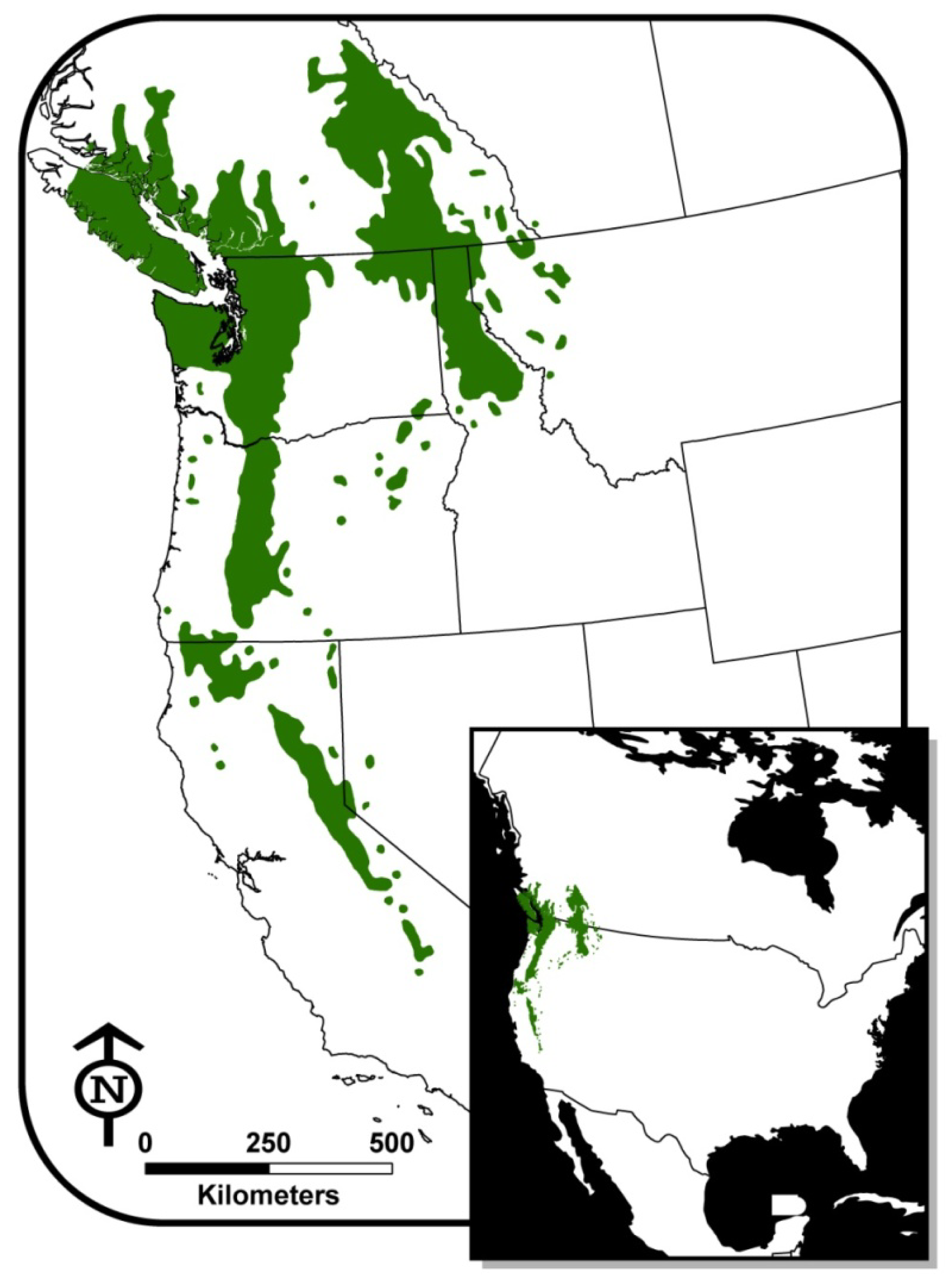

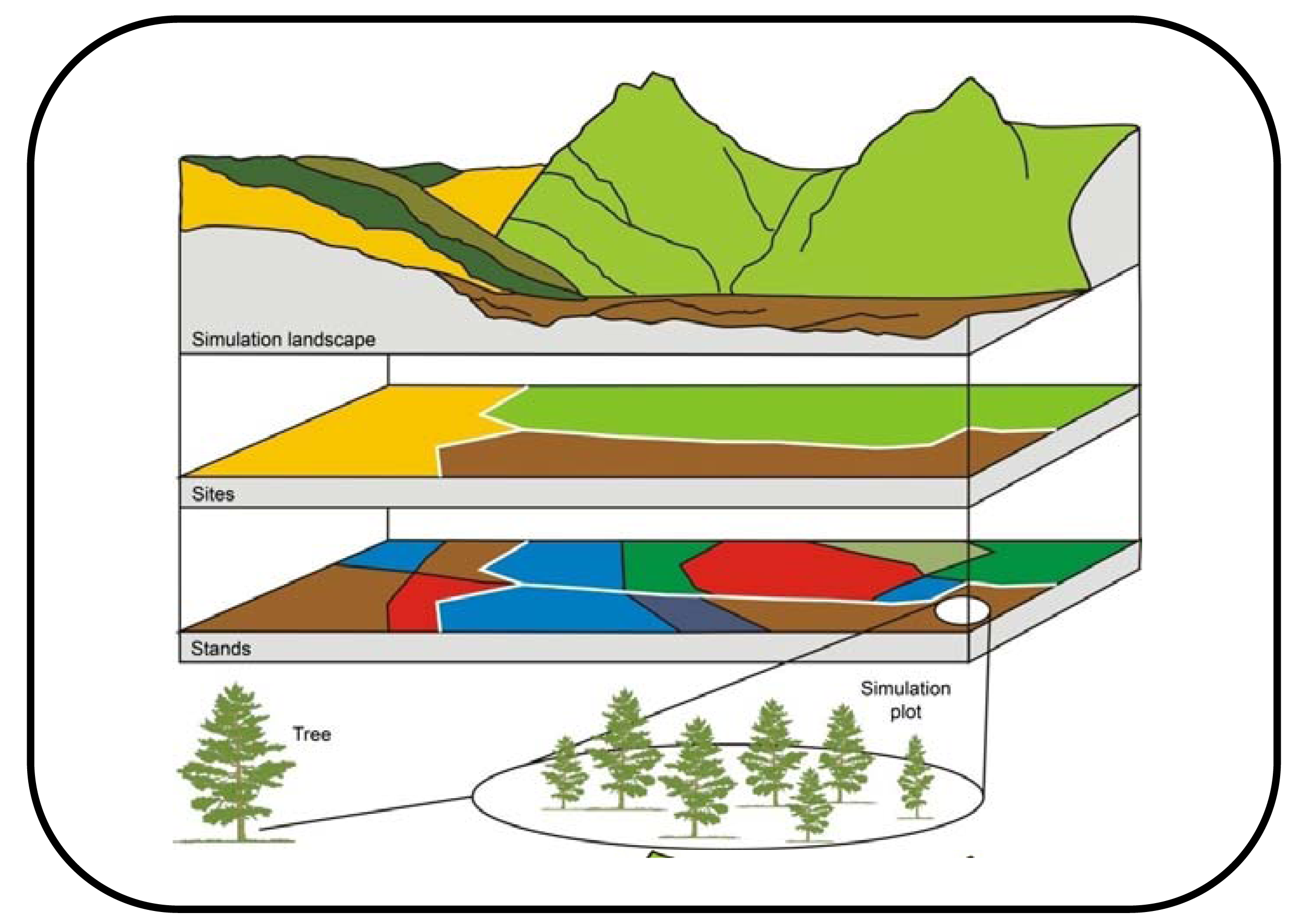
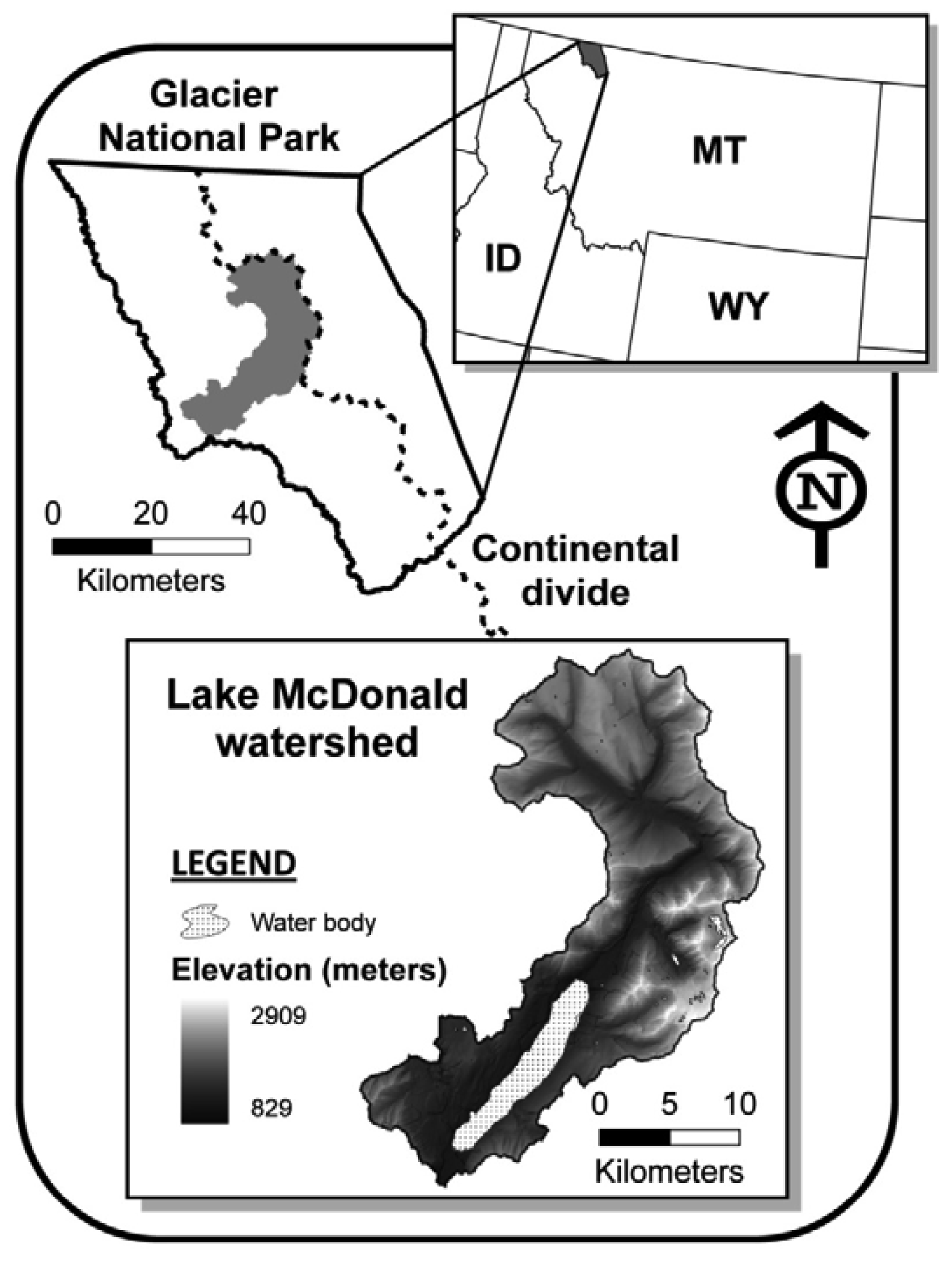
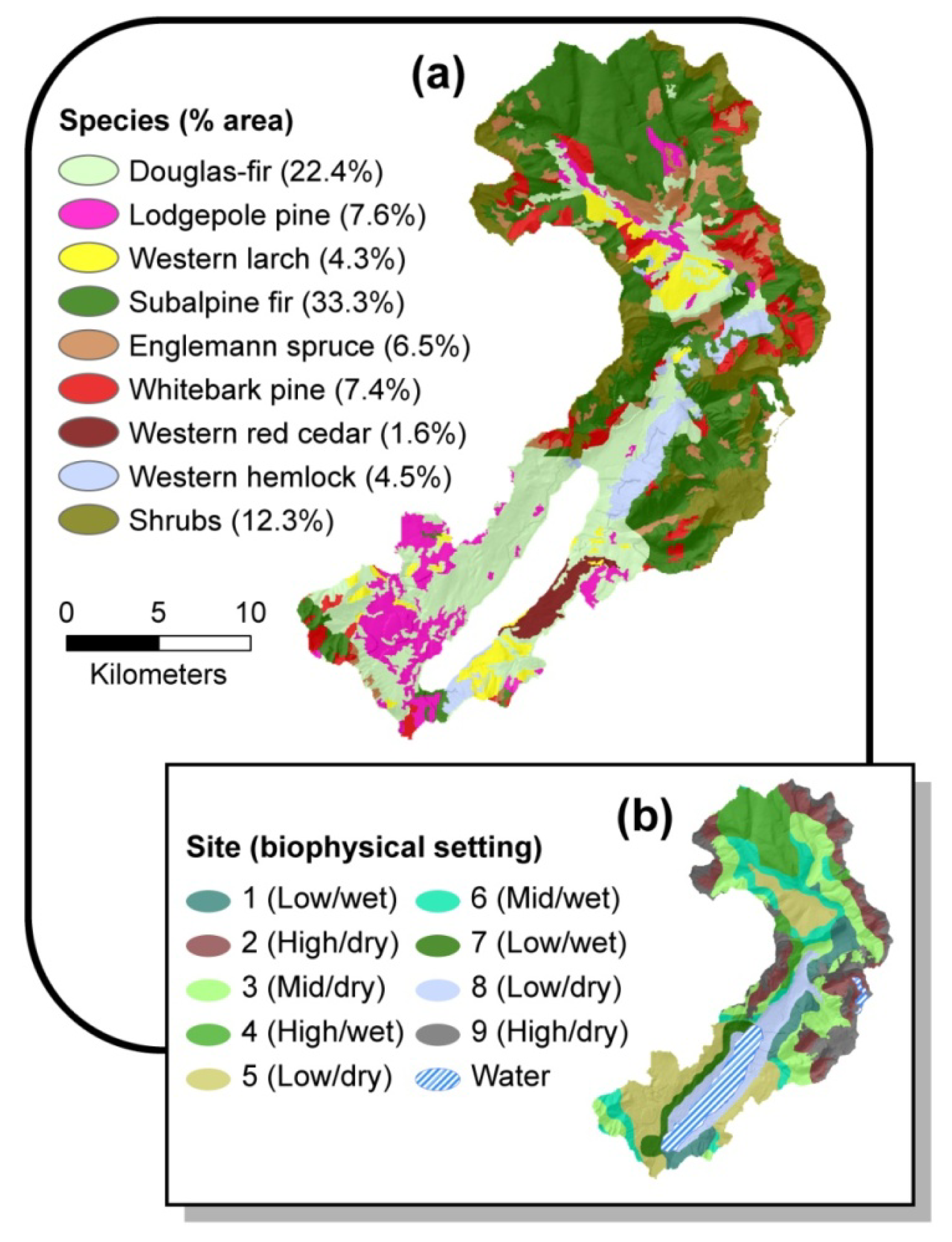
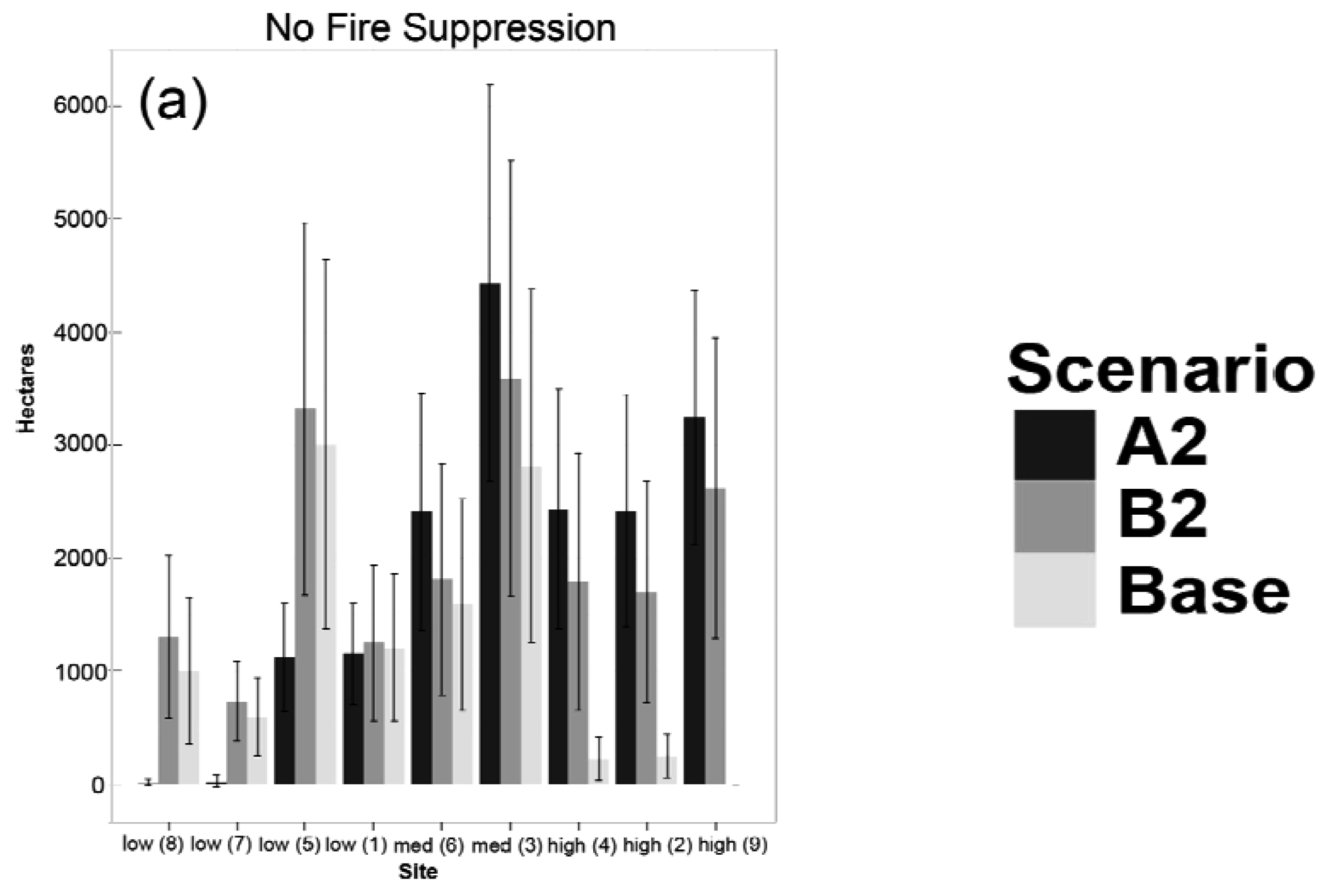
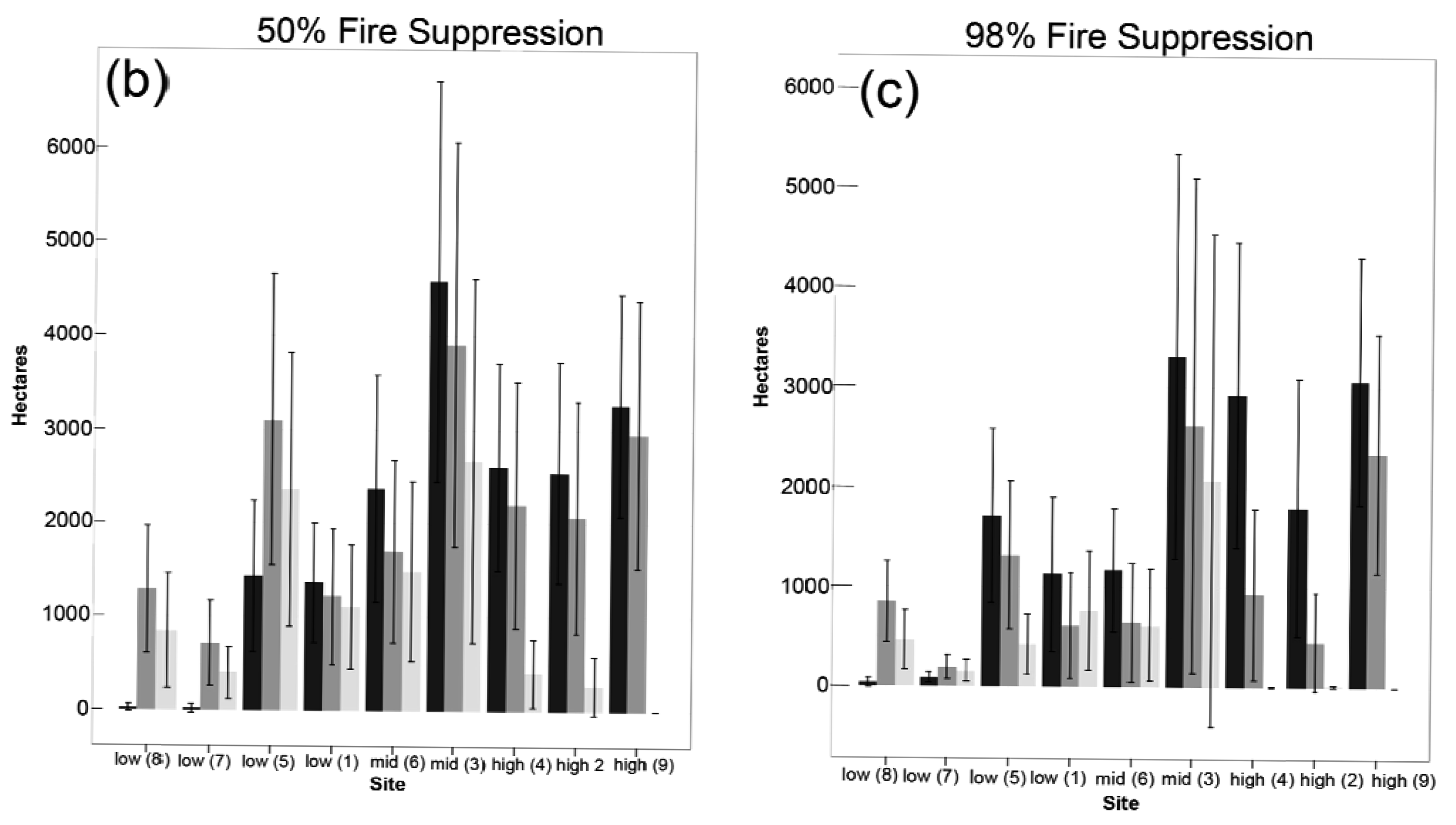
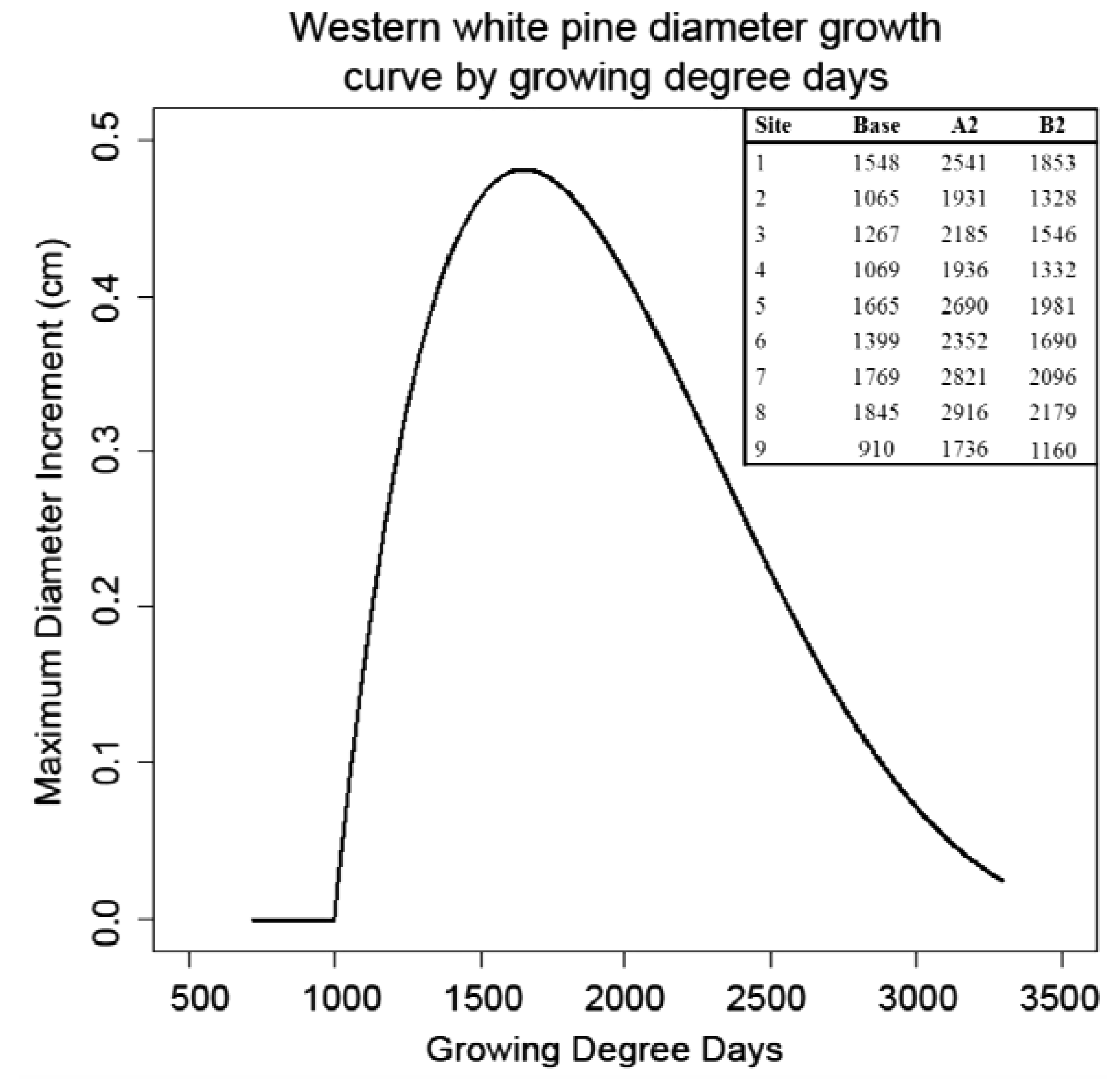

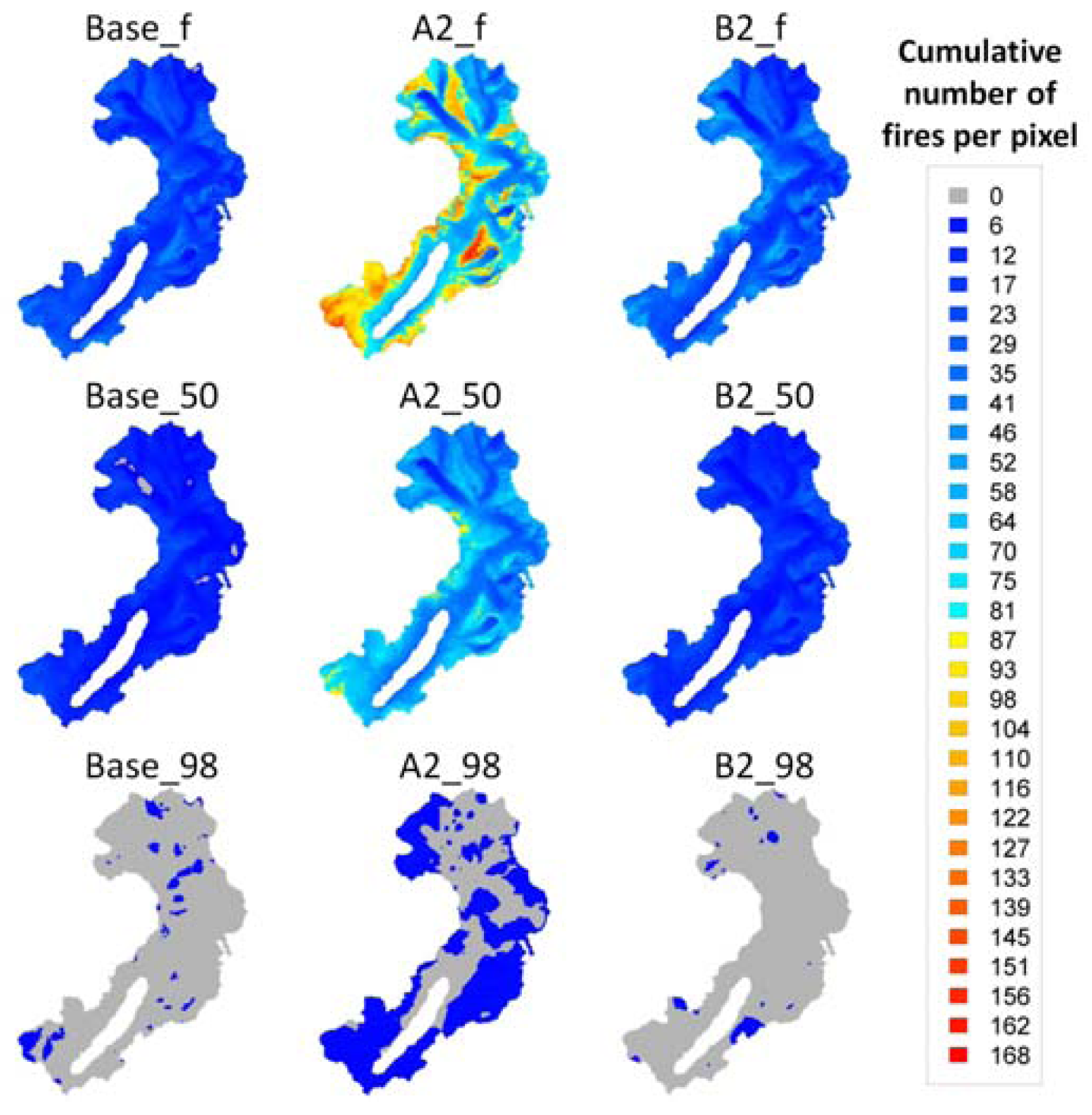
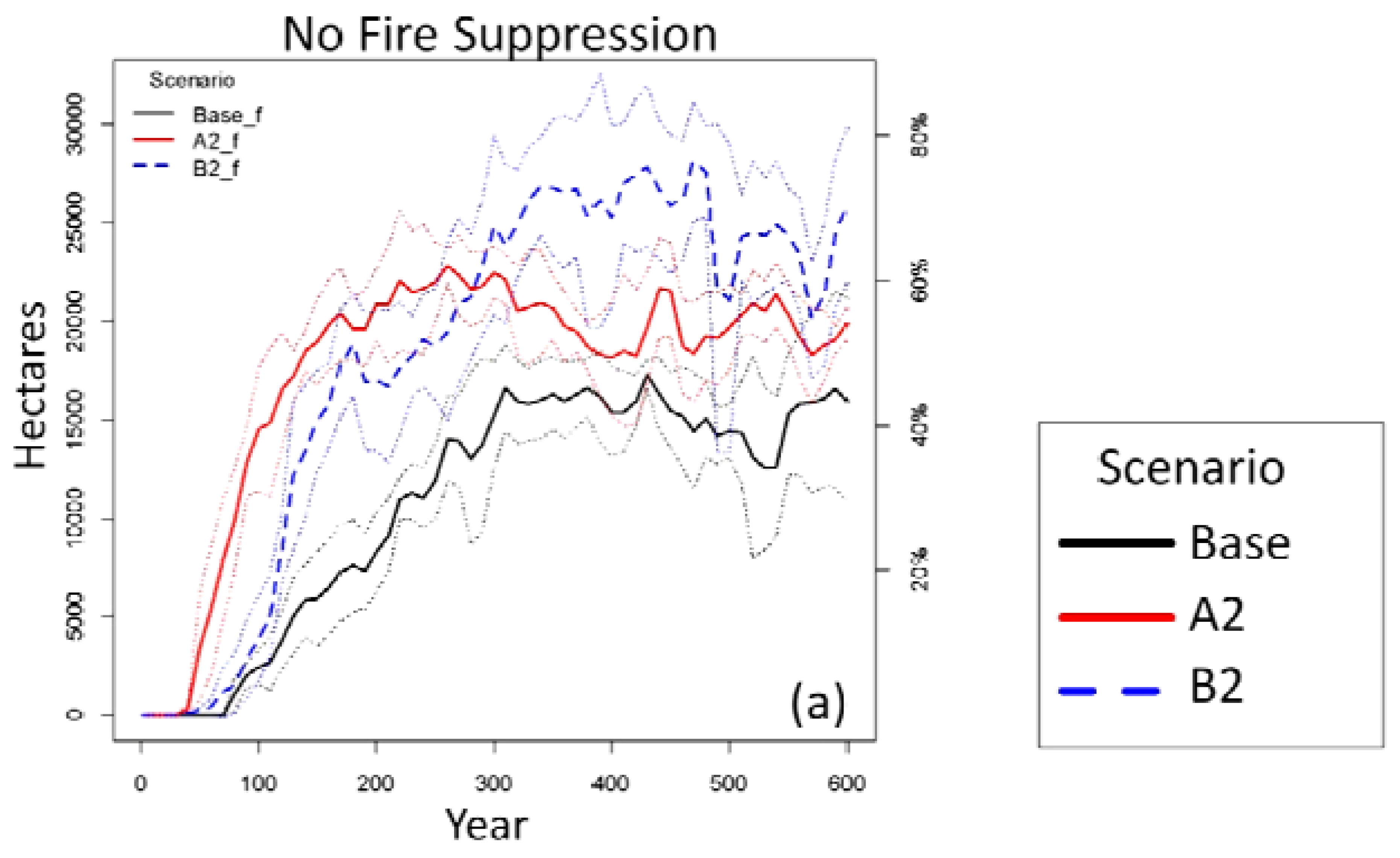
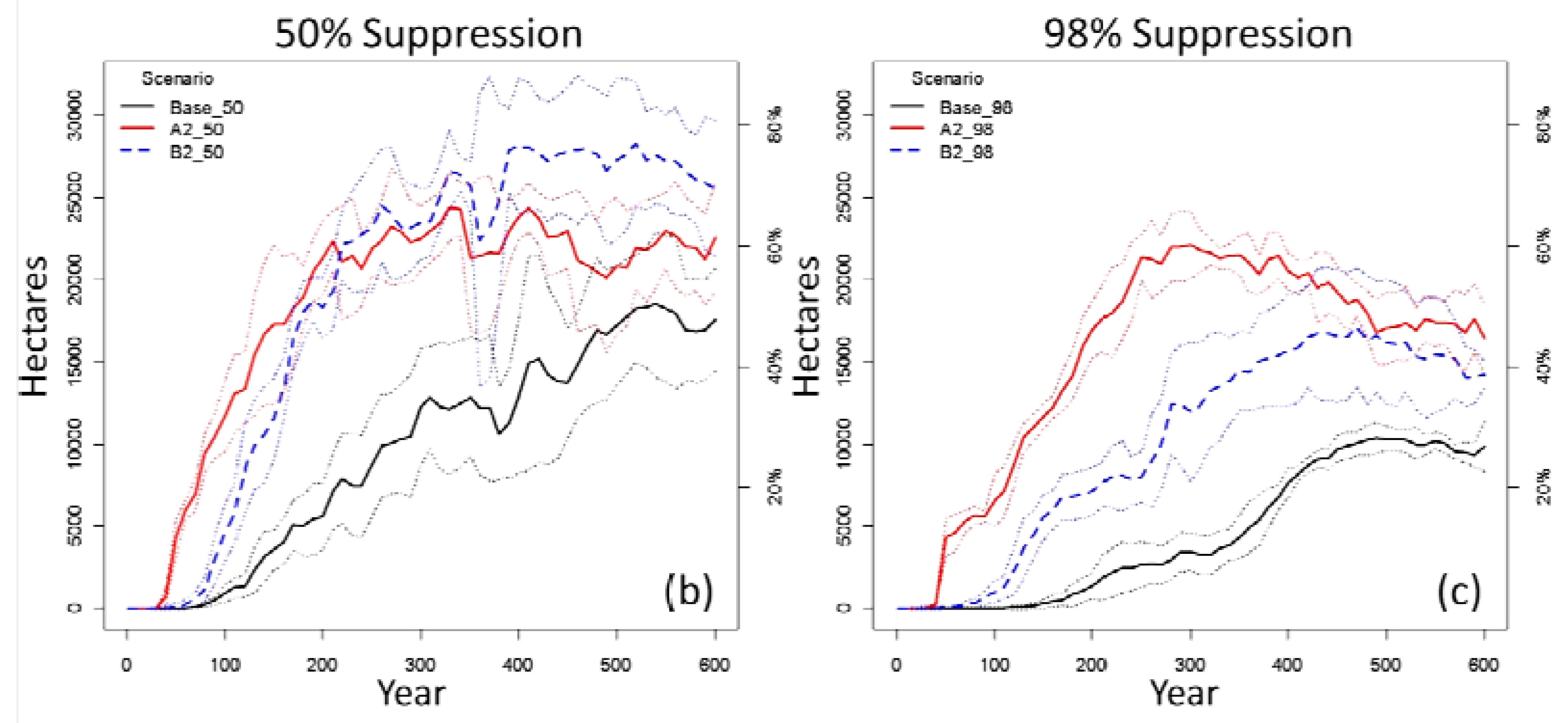
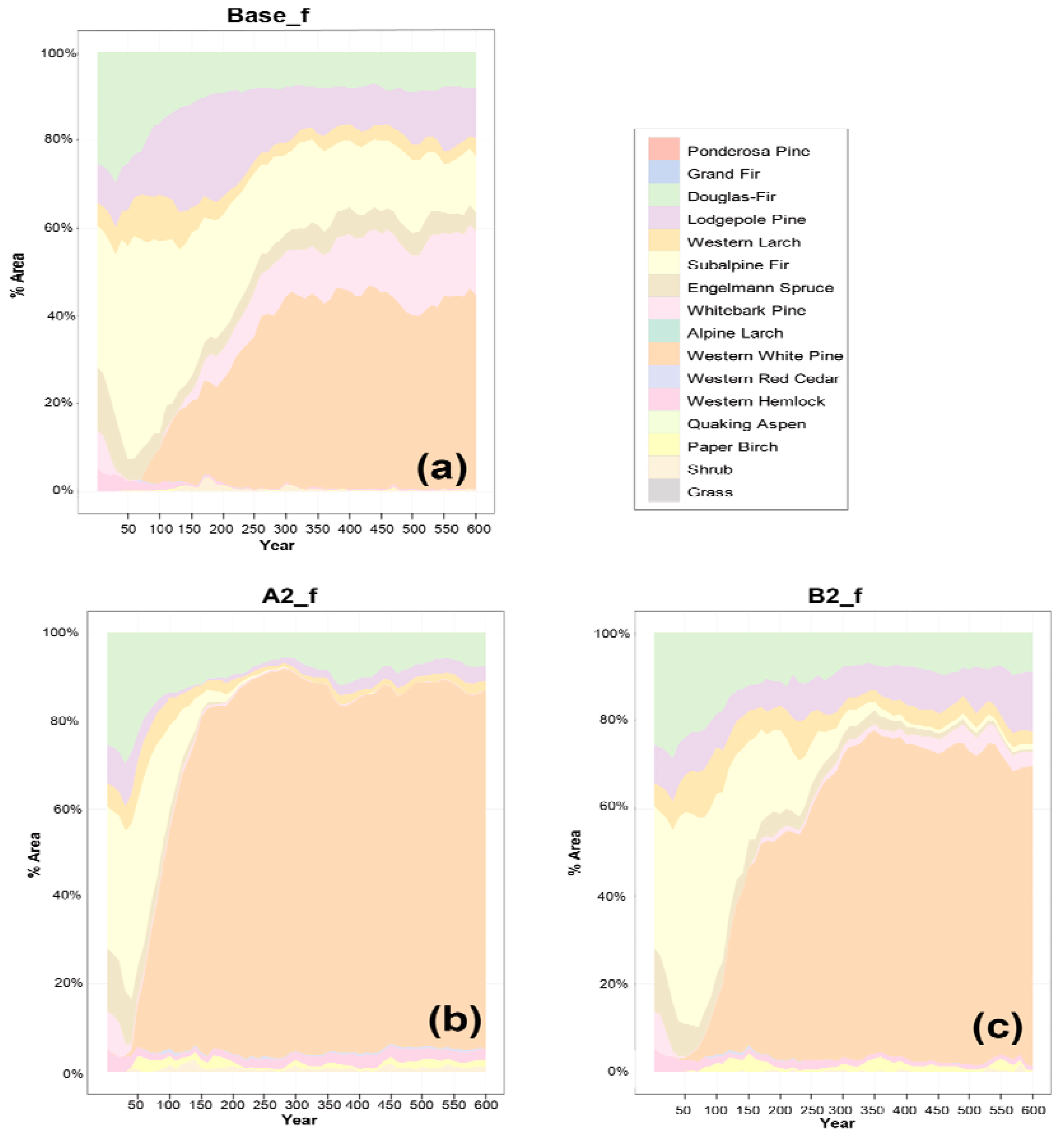

| Climate factors | Fire management factors | ||
|---|---|---|---|
| No fire suppression | 50% fire suppression | 98% fire suppression | |
| Baseline climate | Base_f | Base_50 | Base_98 |
| A2 climate scenario | A2_f | A2_50 | A2_98 |
| B2 climate scenario | B2_f | B2_50 | B2_98 |
| Site | Biophysical setting | Potential vegetation | Elevation range (m) | Elevation mean (m) | Area (ha) |
|---|---|---|---|---|---|
| 1 | Low-elevation, wet | Tsuga heterophylla, | 829-2,354 | 1,397 | 2,840 |
| Abies lasiocarpa, | |||||
| Pseudotsuga menziesii var. glauca | |||||
| 2 | High-elevation, dry | Abies lasiocarpa, | 1,076-2,674 | 1,888 | 4,836 |
| Picea engelmannii, | |||||
| Pinus albicaulis | |||||
| 3 | Mid-elevation, dry | Abies lasiocarpa, | 919-2,714 | 1,650 | 7,881 |
| Pinus albicaulis, | |||||
| Picea engelmannii | |||||
| 4 | High-elevation, wet | Abies lasiocarpa, | 1,081-2,338 | 1,835 | 5,053 |
| Picea engelmannii | |||||
| 5 | Low-elevation, dry | Pseudotsuga menziesii var. glauca, | 831-1,855 | 1,279 | 7,480 |
| Pinus contorta var. contorta, | |||||
| Larix occidentalis | |||||
| 6 | Mid-elevation, wet | Pseudotsuga menziesii var. glauca, | 1,013-2,054 | 1,488 | 4,523 |
| Picea engelmannii, | |||||
| Pinus contorta var. contorta | |||||
| 7 | Low-elevation, wet | Abies lasiocarpa, | 877-1,434 | 1,074 | 1,582 |
| Pinus contorta var. contorta, | |||||
| Tsuga heterophylla | |||||
| 8 | Low-elevation, dry | Abies lasiocarpa | 829-1,199 | 1,026 | 3,749 |
| Tsuga heterophylla, | |||||
| Thuja plicata | |||||
| 9 | High-elevation, dry w/barren areas | Low shrubs | 1,205-2,909 | 2,211 | 5,091 |
| Julian day range | A2 climate | B2 climate |
|---|---|---|
| 1–60 | 2.5 °C, 1.11% | 1.8 °C, 0.99% |
| 61–150 | 3.0 °C, 1.02% | 1.0 °C, 1.17% |
| 151–242 | 6.7 °C, 0.66% | 2.1 °C, 1.24% |
| 243–365 | 4.6 °C, 0.93% | 1.6 °C, 1.05% |
| starting CO2 | 369 | 369 |
| ending CO2 | 856 | 621 |
| No fire suppression | |||
|---|---|---|---|
| Base | A2 | B2 | |
| Mean # fires (SD) | 827 (24.71) | 1,742 (35.53) | 957 (21.75) |
| Mean # fire yrs. (SD) | 350 (4.72) | 493 (10.89) | 390 (4.85) |
| Cumulative area burned, | 183,482 | 633,124 | 240,842 |
| ha (SD) | (14,827.39) | (88,955.27) | (28,170.19) |
| Fire rotation, yrs. | 141 | 41 | 107 |
| Mean fire size, ha | 11.66 | 3.99 | 8.41 |
| Median fire size, ha | 2.79 | 0.81 | 1.89 |
| 50% suppression | |||
| Base | A2 | B2 | |
| Mean # fires (SD) | 407 (23.72) | 918 (31.92) | 519 (9.71) |
| Mean # fire yrs. (SD) | 225 (13.01) | 382 (7.33) | 274 (7.89) |
| Cumulative area burned, | 98,003 | 431,528 | 124,746 |
| ha (SD) | (17,614.48) | (61,551.76) | (17,590.91) |
| Fire rotation, yrs. | 264 | 60 | 207 |
| Mean fire size, ha | 18.89 | 7.92 | 15.57 |
| Median fire size, ha | 6.03 | 1.71 | 4.23 |
| 98% suppression | |||
| Base | A2 | B2 | |
| Mean # fires (SD) | 14 (6.10) | 38 (6.91) | 19 (4.83) |
| Mean # fire yrs. (SD) | 9 (4.87) | 28 (3.56) | 15 (4.47) |
| Cumulative area burned, | 3,508 | 18,597 | 4,183 |
| ha (SD) | (4,102.43) | (17,128.46) | (4,274.28) |
| Fire rotation, yrs. | 7363 | 1389 | 6175 |
| Mean fire size, ha | 28.99 | 36.12 | 25.20 |
| Median fire size, ha | 8.33 | 13.23 | 9.77 |
Acknowledgments
This research was funded in part by the Joint Fire Sciences Program under Project JFSP 09-3-01-17. The authors gratefully acknowledge the contributions of the large number of skilled researchers, ecologists, and biological technicians who have participated in many phases of this research. In particular, we thank Alisa Keyser (UC Merced), Dan Fagre (USGS), Matt Rollins (USGS), Isaac Grenfell (USFS), and Emily Schembra (USFS).
References
- Lenihan, J.M.; Drapek, R.; Bachelet, D.; Neilson, R.P. Climate change effects on vegetation distribution, carbon, and fire in California. Ecol. Appl. 2003, 13, 1667–1681. [Google Scholar]
- Bentz, B.; Régnière, J.; Fettig, C.; Hansen, E.; Hayes, J.; Hicke, J.; Kelsey, R.; Negrón, J.; Seybold, S. Climate change and bark beetles of the western United States and Canada: Direct and indirect effects. BioScience 2010, 60, 602–613. [Google Scholar]
- McKenzie, D.; Gedalof, Z.; Peterson, D.L.; Mote, P. Climatic change, wildfire, and conservation. Conserv. Biol. 2004, 18, 890–902. [Google Scholar]
- Flannigan, M.; Stocks, B.; Wotton, B. Climate change and forest fires. Sci. Total Environ. 2000, 262, 221–229. [Google Scholar]
- Dale, V.H.; Joyce, L.A.; McNulty, S.; Neilson, R.P.; Ayres, M.P.; Flannigan, M.D.; Hanson, P.J.; Irland, L.C.; Lugo, A.E.; Peterson, C.J.; Simberloff, D.; Swanson, F.J.; Stocks, B.J.; Wotton, B.M. Climate change and forest disturbances. BioScience 2001, 51, 723–734. [Google Scholar]
- Fagre, D.B.; Peterson, D.L. Ecosystem dynamics and disturbance in mountain wildernesses: Assessing vulnerability of natural resources to change. In Wilderness Science in a Time of Change, Vol. 3: Wilderness as a Place for Scientific Inquiry; McCool, S.F., Cole, D.N., Borrie, W.T., O'Loughlin, J., Eds.; Rocky Mountain Research Station, USDA Forest Service: Ogden, UT, USA, 2000; pp. 74–81. [Google Scholar]
- Rehfeldt, G.E.; Crookston, N.L.; Warwell, M.V.; Evans, J.S. Empirical analyses of plant-climate relationships for the Western United States. Int. J. Plant Sci. 2006, 167, 1123–1150. [Google Scholar]
- Van Mantgem, P.J.; Stephenson, N.L.; Byrne, J.C.; Daniels, L.D.; Franklin, J.F.; Fule, P.Z.; Harmon, M.E.; Larson, A.J.; Smith, J.M.; Taylor, A.H.; Veblen, T.T. Widespread increase of tree mortality rates in the Western United States. Science 2009, 323, 521–524. [Google Scholar]
- Tomback, D.; Achuff, P. Blister rust and western forest biodiversity: Ecology, values and outlook for white pines. For. Pathol. 2010, 40, 186–225. [Google Scholar]
- Keane, R.E.; Loehman, R.A.; Holsinger, L.M. The FireBGCv2 Landscape Fire and Succession Model: A Research Simulation Platform for Exploring Fire and Vegetation Dynamics; US Department of Agriculture, Forest Service, Rocky Mountain Research Station: Fort Collins, CO, USA, 2011; p. 137. [Google Scholar]
- Bowman, D.M.J.S.; Balch, J.K.; Artaxo, P.; Bond, W.J.; Carlson, J.M.; Cochrane, M.A.; D'Antonio, C.M.; DeFries, R.S.; Doyle, J.C.; Harrison, S.P. Fire in the earth system. Science 2009, 324, 481–484. [Google Scholar]
- Westerling, A.L.; Turner, M.G.; Smithwick, E.A.H.; Romme, W.H.; Ryan, M.G. Continued warming could transform Greater Yellowstone fire regimes by mid-21st century. Proc. Natl. Acad. Sci. USA 2011, 108, 13165–13170. [Google Scholar]
- Keane, R.E.; Veblen, T.; Ryan, K.C.; Logan, J.; Allen, C.; Hawkes, B. The cascading effects of fire exclusion in the Rocky Mountains. In Rocky Mountain Futures: An Ecological Perspective; Baron, J., Ed.; Island Press: Washington, DC, USA, 2002; pp. 133–153. [Google Scholar]
- Millar, C.I.; Westfall, R.D.; Delany, D.L.; King, J.C.; Graumlich, L.J. Response of subalpine conifers in the Sierra Nevada, California, USA, to 20th-century warming and decadal climate variability. Arct. Antarct. Alp. Res. 2004, 36, 181–200. [Google Scholar]
- Climate Change 2007: Synthesis Report. Contribution of Working Groups I, II, and III to the Fourth Assessment Report of the Intergovernmental Panel on Climate Change; IPCC: Geneva, Switzerland, 2007; p. 104.
- Littell, J.; McKenzie, D.; Peterson, D.; Westerling, A. Climate and wildfire area burned in western US ecoprovinces, 1916–2003. Ecol. Appl. 2009, 19, 1003–1021. [Google Scholar]
- Westerling, A.L.; Hidalgo, H.G.; Cayan, D.R.; Swetnam, T.W. Warming and earlier spring increase Western US forest wildfire activity. Science 2006, 313, 940–943. [Google Scholar]
- Heyerdahl, E.K.; McKenzie, D.; Daniels, L.D.; Hessl, A.E.; Littell, J.S.; Mantua, N.J. Climate drivers of regionally synchronous fires in the inland Northwest (1651-1900). Int. J. Wildland Fire 2008, 17, 40–49. [Google Scholar]
- Schoennagel, T.; Veblen, T.T.; Romme, W.H. The interaction of fire, fuels, and climate across Rocky Mountain forests. BioScience 2004, 54, 661–676. [Google Scholar]
- Heimann, M.; Reichstein, M. Terrestrial ecosystem carbon dynamics and climate feedbacks. Nature 2008, 451, 289–292. [Google Scholar]
- Boisvenue, C.; Running, S.W. Simulations show decreasing carbon stocks and potential for carbon emissions in Rocky Mountain forests over the next century. Ecol. Appl. 2010, 20, 1302–1319. [Google Scholar]
- Giorgi, F.; Mearns, L.O. Calculation of average, uncertainty range, and reliability of regional climate changes from AOGCM simulations via the “reliability ensemble averaging” (REA) method. J. Clim. 2002, 15, 1141–1158. [Google Scholar]
- Christensen, J.H.; Hewitson, B.; Busuioc, A.; Chen, A.; Gao, X.; Held, I.; Jones, R.; Kolli, R.K.; Kwon, W.-T.; Laprise, R.; et al. Regional climate projections. In Climate Change 2007: The Physical Science Basis. Contribution of Working Group I to the Fourth Assessment Report of the Intergovernmental Panel on Climate Change; Solomon, S., Qin, D., Manning, M., Chen, Z., Marquis, M., Averyt, K.B., Tignor, M., Miller, H.L., Eds.; Cambridge University Press: Cambridge, UK; New York, NY, USA, 2007; pp. 848–940. [Google Scholar]
- Flannigan, M.D.; Amiro, B.D.; Logan, K.A.; Stocks, B.J.; Wotton, B.M. Forest fires and climate change in the 21st century. Mitig. Adapt. Strat. Glob. Chang. 2006, 11, 847–859. [Google Scholar]
- Torn, M.S.; Fried, J.S. Predicting the impacts of global warming on wildland fire. Clim. Chang. 1992, 21, 257–274. [Google Scholar]
- Sturrock, R.N.; Frankel, S.J.; Brown, A.V.; Hennon, P.E.; Kliejunas, J.T.; Lewis, K.J.; Worrall, J.J.; Woods, A.J. Climate change and forest diseases. Plant Pathol. 2011, 60, 133–149. [Google Scholar]
- Hepting, G.H. Climate and forest diseases. Annu. Rev. Phytopathol. 1963, 1, 31–50. [Google Scholar]
- Kinloch, B.B., Jr. White pine blister rust in North America: Past and prognosis. Phytopathology 2003, 93, 1044–1047. [Google Scholar]
- Kim, M.S.; Richardson, B.A.; McDonald, G.I.; Klopfenstein, N.B. Genetic diversity and structure of western white pine (Pinus monticola) in North America: A baseline study for conservation, restoration, and addressing impacts of climate change. Tree Genet. Genomes 2010, 7, 11–21. [Google Scholar]
- Fowells, H.A. Silvics of Forest Trees of the United States; US Department of Agriculture: Washington, DC, USA, 1965; p. 762. [Google Scholar]
- Little, E.L., Jr. Digital Representation of “Atlas of United States Trees”; U.S. Geological Survey Professional Paper 1650; U.S. Geological Survey: Reston, VA, USA, 1999. [Google Scholar]
- Little, E.L., Jr. Atlas of United States Trees: Volume 1. Conifers and Important Hardwoods; US Department Agriculture, Miscellaneous Publication No. 1146; US Government Printing Office: Washington, DC, USA, 1971. [Google Scholar]
- Graham, R.T. Pinus monticola Dougl ex D. Don, Western White Pine. In Silvics of North America; Conifers; Burns, R.M., Honkala, B.H., Eds.; US Department of Agriculture, Forest Service: Washington, DC, USA, 1990; Volume 1, pp. 385–394. [Google Scholar]
- Griffith, R.S. Pinus Monticola. In Fire Effects Information System; US Department of Agriculture, Forest Service, Rocky Mountain Research Station, Fire Sciences Laboratory: Washington, DC, USA, 1992. [Google Scholar]
- Habeck, J.R. Forest succession in the Glacier Park cedar-hemlock forests. Ecology 1968, 49, 872–880. [Google Scholar]
- Habeck, J.R. The Vegetation of Glacier National Park, Montana; Final Report on file at Glacier National Park; US Department of Interior National Park Service: West Glacier, MT, USA, 1970; p. 132. [Google Scholar]
- Habeck, J.R.; Mutch, R.W. Fire-dependent forests in the northern Rocky Mountains. Quat. Res. 1973, 3, 408–424. [Google Scholar]
- Harvey, A.E.; Byler, J.W.; McDonald, G.I.; Neuenschwander, L.F.; Tonn, J.R. Death of an Ecosystem: Perspectives on Western White Pine Ecosystems of North America at the End of the Twentieth Century; US Department of Agriculture, Forest Service, Rocky Mountain Research Station: Fort Collins, CO, USA, 2008; p. 10. [Google Scholar]
- Ryan, M.G.; Harmon, M.E.; Birdsey, R.A.; Giardina, C.P.; Heath, L.S.; Houghton, R.A.; Jackson, R.B.; McKinley, D.C.; Morrison, J.F.; Murray, B.C. A synthesis of the science on forests and Carbon for US Forests. Issues Ecol. 2010, 13, 1–16. [Google Scholar]
- Zeglen, S.; Pronos, J.; Merler, H. Silvicultural management of white pines in western North America. For. Pathol. 2010, 40, 347–368. [Google Scholar]
- Ketcham, D.E.; Wellner, C.A.; Evans, S.S. Western white pine management programs realigned on Northern Rocky Mountain National Forests. J. For. 1968, 66, 329–332. [Google Scholar]
- Lowery, D. Western White Pine; US Department of Agriculture, Forest Service: Washington, DC, USA, 1984; p. 7. [Google Scholar]
- Schwandt, J.W.; Lockman, I.B.; Kliejunas, J.T.; Muir, J.A. Current health issues and management strategies for white pines in the western United States and Canada. For. Pathol. 2010, 40, 226–250. [Google Scholar]
- Samman, S.; Schwandt, J.W.; Wilson, J.L. Managing for Healthy White Pine Ecosystems in the United States to Reduce the Impacts of White Pine Blister Rust; US Department of Agriculture, Forest Service: Missoula, MT, USA, 2003; p. 10. [Google Scholar]
- Harvey, A.E.; Hessburg, P.F.; Byler, J.W.; McDonald, G.I.; Weatherby, J.C.; Wickman, B.E. Health declines in western interior forests: Symptoms and solutions. Proceedings of Ecosystem Management in Western Interior Forests, Spokane, WA, USA, 3–5 May 1994; Cooperative Extension, Washington State University: Pullman, WA, USA, 1994. [Google Scholar]
- McDonald, G.I.; Hoff, R.J.; Tomback, D.F.; Arno, S.F.; Keane, R.E. Blister rust: An introduced plague. In Whitebark Pine Communities. Ecology and Restoration; Tomback, D.F., Arno, S.F., Keane, R.E., Eds.; Island Press: Washington, DC, USA, 2001; pp. 193–220. [Google Scholar]
- Maloy, O.C. White pine blister rust control in North America: A case history. Annu. Rev. Phytopathol. 1997, 35, 87–109. [Google Scholar]
- Zambino, P.J. Biology and pathology of ribes and their implications for management of white pine blister rust. For. Pathol. 2010, 40, 264–291. [Google Scholar]
- Graham, R.T.; Harvey, A.E.; Jain, T.B.; Tonn, J.R. The Effects of Thinning and Similar Stand Treatments on Fire Behavior in Western Forests; General Technical Report PNW-GTR-463; Pacific Northwest Research Station, USDA Forest Service: Washington, DC, USA, 1999. [Google Scholar]
- Keane, R.E.; Morgan, P.; White, J.D. Temporal patterns of ecosystem processes on simulated landscapes in Glacier National Park, Montana, USA. Landsc. Ecol. 1999, 14, 311–329. [Google Scholar]
- Keane, R.E.; Ryan, K.; Finney, M. Simulating the consequences of fire and climate regimes on a complex landscape in Glacier National Park, USA. Tall Timbers 1998, 20, 310–324. [Google Scholar]
- Keane, R.E.; Ryan, K.C.; Running, S.W. Simulating effects of fire on northern Rocky Mountain landscapes with the ecological process model FIRE-BGC. Tree Physiol. 1996, 16, 319–331. [Google Scholar]
- Running, S.W.; Hunt, E.R., Jr. Generalization of a forest ecosystem process model for other biomes, BIOME-BGC, and an application for global-scale models. In Scaling Physiological Processes: Leaf to Globe; Ehleringer, J.R., Ed.; Academic Press: London, UK, 1993; pp. 141–158. [Google Scholar]
- Running, S.W.; Coughlan, J.C. A general model of forest ecosystem processes for regional applications I. Hydrologic balance, canopy gas exchange and primary production processes. Ecol. Model. 1988, 42, 125–154. [Google Scholar]
- McDonald, G.I.; Hoff, R.J.; Wykoff, W. Computer Simulation of White Pine Blister Rust Epidemics: Model Formulation; US Department of Agriculture, Forest Service, Intermountain Forest and Range Experiment Station: Washington, DC, USA, 1981. [Google Scholar]
- Howell, B.; Burns, K.S.; Kearns, H.S.J.; Witcosky, J.J.; Cross, F.J. Biological evaluation of a model for predicting presence of white pine blister rust in Colorado based on climatic variable and susceptible white pine species distribution. Biological Evaluation R2-06-04. 2006, 1–15. [Google Scholar]
- King, J.N.; David, A.; Noshad, D.; Smith, J. A review of genetic approaches to the management of blister rust in white pines. For. Pathol. 2010, 40, 292–313. [Google Scholar]
- Finklin, A.I. A Climatic Handbook for Glacier National Park: With Data for Waterton Lakes National Park; US Department of Agriculture, Forest Service, Intermountain Research Station: Ogden, UT, USA, 1986; p. 55. [Google Scholar]
- Habeck, J.; Mutch, R. Fire-dependent forests in the northern Rocky Mountains. Quat. Res. 1973, 3, 408–424. [Google Scholar]
- Kessell, S.R. Gradient Modeling: Resource and Fire Management; DeSanto, R.S., Ed.; Springer-Verlag: New York, NY, USA, 1979; p. 432. [Google Scholar]
- Habeck, J.R.; Choate, C.M. An analysis of Krummholz Communities at Logan Pass, Glacier National Park. Northwest Sci. 1963, 37, 165–166. [Google Scholar]
- Barrett, S.W.; Arno, S.F.; Key, C.H. Fire regimes of western larch-lodgepole pine forests in Glacier National Park, Montana. Can. J. For. Res. 1991, 21, 1711–1720. [Google Scholar]
- Barrett, S.W. Fire History of Glacier National Park: Middle Fork Flathead River Drainage, in National Park Service, Glacier National Park, West Glacier, MT; US Department of Agriculture, Forest Service, Intermountain Research Station: Missoula, MT, USA, 1986. [Google Scholar]
- Habeck, J.R. Fire Ecology Investigations in Glacier National Park—Historical Considerations and Current Observations; Final Report on file at Glacier National Park; US Department of Interior National Park Service: West Glacier, MT, USA, 1970; p. 80. [Google Scholar]
- NCDC. Daily Surface Data; US Department of Commerce National Climatic Data Center: Asheville, NC, USA, 2011. [Google Scholar]
- Hungerford, R.D.; Nemani, R.R.; Running, S.W.; Coughlan, J.C. MTCLIM: A Mountain Microclimate Simulation Model; US Department of Agriculture, Forest Service, Intermountain Research Station: Ogden, UT, USA, 1989; pp. 1–52. [Google Scholar]
- Running, S.W.; Nemani, R.R.; Hungerford, R.D. Extrapolation of synoptic meteorological data in mountainous terrain and its use for simulating forest evapotranspiration and photosynthesis. Can. J. For. Res. 1987, 17, 472–483. [Google Scholar]
- Mote, P. CLIMET Downscaled HadCM 3 Model Output, SRES A2 and B2, Northern Rocky Mountain Region. 2003. [Google Scholar]
- Nakicenovic, N.; Alcamo, J.; Davis, G.; de Vries, B.; Fenhann, J.; Gaffin, S.; Gregory, K.; Grubler, A.; Jung, T.Y.; Kram, T.; et al. Special Report on Emissions Scenarios: A Special Report of Working Group III of the Intergovernmental Panel on Climate Change; Cambridge University Press: Cambridge, UK, 2000; p. 612. [Google Scholar]
- Hood, S.M. Mitigating Old Tree Mortality in Long-Unburned, Fire-Dependent Forests: A Synthesis; US Department of Agriculture, Forest Service, Rocky Mountain Research Station: Fort Collins, CO, USA, 2010; p. 71. [Google Scholar]
- Stephens, S.L.; Ruth, L.W. Federal forest-fire policy in the United States. Ecol. Appl. 2005, 15, 532–542. [Google Scholar]
- R Development Core Team. R: A Language and Environment for Statistical Computing; R Foundation for Statistical Computing: Vienna, Austria, 2010. [Google Scholar]
- Morgan, P.; Heyerdahl, E.; Gibson, C. Multi-season climate synchronized forest fires throughout the 20th century, northern Rockies, USA. Ecology 2008, 89, 717–728. [Google Scholar]
- Kitzberger, T.; Brown, P.; Heyerdahl, E.; Swetnam, T.; Veblen, T. Contingent Pacific–Atlantic Ocean influence on multicentury wildfire synchrony over western North America. Proc. Natl. Acad. Sci. USA 2007, 104, 543. [Google Scholar]
- Heikkinen, R.; Luoto, M.; Araújo, M.; Virkkala, R.; Thuiller, W.; Sykes, M. Methods and uncertainties in bioclimatic envelope modelling under climate change. Prog. Phys. Geogr. 2006, 30, 751. [Google Scholar]
- Hampe, A. Bioclimate envelope models: What they detect and what they hide. Glob. Ecol. Biogeogr. 2004, 13, 469–471. [Google Scholar]
- Sinclair, S.J.; White, M.D.; Newell, G.R. How useful are species distribution models for managing biodiversity under future climates? Ecol. Soc. 2010, 15, 8. [Google Scholar]
- Millar, C.I.; Stephenson, N.L.; Stephens, S.L. Climate change and forests of the future: Managing in the face of uncertainty. Ecol. Appl. 2007, 17, 2145–2151. [Google Scholar]
- Schrag, A.M.; Bunn, A.G.; Graumlich, L.J. Influence of bioclimatic variables on tree-line conifer distribution in the Greater Yellowstone Ecosystem: Implications for species of conservation concern. J. Biogeogr. 2008, 35, 698–710. [Google Scholar]
- Perry, G.L.W.; Millington, J.D.A. Spatial modelling of succession-disturbance dynamics in forest ecosystems: Concepts and examples. Perspect. Plant Ecol. Evol. Syst. 2008, 9, 191–210. [Google Scholar]
- Taylor, A.R.; Chen, H.Y.H.; van Damme, L. A review of forest succession models and their suitability for forest management planning. For. Sci. 2009, 55, 23–36. [Google Scholar]
- He, H.S.; Keane, R.E.; Iverson, L.R. Forest landscape models, a tool for understanding the effect of the large-scale and long-term landscape processes. For. Ecol. Manag. 2008, 254, 371–374. [Google Scholar]
- Keane, R.E.; Cary, G.J.; Davies, I.D.; Flannigan, M.D.; Gardner, R.H.; Lavorel, S.; Lenihan, J.M.; Li, C.; Rupp, T.S. A classification of landscape fire succession models: Spatial simulations of fire and vegetation dynamics* 1. Ecol. Model. 2004, 179, 3–27. [Google Scholar]
- Seidl, R.; Fernandes, P.M.; Fonseca, T.F.; Gillet, F.; Jönsson, A.M.; Merganicová, K.; Netherer, S.; Arpaci, A.; Bontemps, J.D.; Bugmann, H. Modelling natural disturbances in forest ecosystems: A review. Ecol. Model. 2011, 222, 903–924. [Google Scholar]
- Littell, J.S.; McKenzie, D.; Peterson, D.L.; Westerling, A.L. Climate and wildfire area burned in western US ecoprovinces, 1916–2003. Ecol. Appl. 2009, 19, 1003–1021. [Google Scholar]
- Whitlock, C.; Shafer, S.L.; Marlon, J. The role of climate and vegetation change in shaping past and future fire regimes in the northwestern US and the implications for ecosystem management. For. Ecol. Manag. 2003, 178, 5–21. [Google Scholar]
- Brown, T.J.; Hall, B.L.; Westerling, A.L. The impact of twenty-first century climate change on wildland fire danger in the western United States: An applications perspective. Clim. Chang. 2004, 62, 365–388. [Google Scholar]
- Flannigan, M.; Stocks, B.; Turetsky, M.; Wotton, M. Impacts of climate change on fire activity and fire management in the circumboreal forest. Glob. Chang. Biol. 2008, 14, 1–12. [Google Scholar]
- Graham, R.T.; Harvey, A.E.; Jain, T.B.; Tonn, J.R. The effects of thinning and similar stand treatments on fire behavior in Western forests; General Technical Report PNW-GTR-463, USDA Forest Service; Pacific Northwest Research Station: Portland, OR, USA, 1999. [Google Scholar]
- Hall, M.H.P.; Fagre, D.B. Modeled climate-induced glacier change in Glacier National Park, 1850-2100. BioScience 2003, 53, 131–140. [Google Scholar]
- Fagre, D.B.; Peterson, D.L.; Hessl, A.E. Taking the pulse of mountains: Ecosystem responses to climatic variability. Clim. Chang. 2003, 59, 263–282. [Google Scholar]
- White, J.D.; Running, S.W.; Thornton, P.E.; Keane, R.E.; Ryan, K.C.; Fagre, D.B.; Key, C.H. Assessing simulated ecosystem processes for climate variability research at glacier national park, USA. Ecol. Appl. 1998, 8, 805–823. [Google Scholar]
- Lenihan, J.M.; Bachelet, D.; Neilson, R.P.; Drapek, R. Response of vegetation distribution, ecosystem productivity, and fire to climate change scenarios for California. Clim. Chang. 2008, 87, 215–230. [Google Scholar]
- Agee, J. Fire Ecology of Pacific Northwest Forests; Island Press: Washington, DC, USA, 1996; p. 493. [Google Scholar]
- Schoettle, A.W.; Sniezko, R.A. Proactive intervention to sustain high-elevation pine ecosystems threatened by white pine blister rust. J. For. Res. 2007, 12, 327–336. [Google Scholar]
- Gibson, C.E.; Morgan, P. Atlas of Digital Polygon Fire Extents for Idaho and Western Montana (1889-2003); US Department of Agriculture, Forest Service, Rocky Mountain Research Station: Fort Collins, CO, USA, 2009. Available online: http://www.fs.fed.us/rm/data_archive (accessed on 23 September 2011).
- Iverson, L.R.; Prasad, A.M.; Matthews, S.N.; Peters, M. Estimating potential habitat for 134 eastern US tree species under six climate scenarios. For. Ecol. Manag. 2008, 254, 390–406. [Google Scholar]
- Morin, X.; Thuiller, W. Comparing niche-and process-based models to reduce prediction uncertainty in species range shifts under climate change. Ecology 2009, 90, 1301–1313. [Google Scholar]
- Walck, J.L.; Hidayati, S.N.; Dixon, K.W.; Thompson, K.E.N.; Poschlod, P. Climate change and plant regeneration from seed. Glob. Chang. Biol. 2011, 17, 2145–2161. [Google Scholar]
- Pilkey, O.H.; Pilkey-Jarvis, L. Useless Arithmetic: Why Environmental Scientists can't Predict the Future; Columbia University Press: New York, NY, USA, 2007. [Google Scholar]
- Noss, R.F. Beyond Kyoto: Forest management in a time of rapid climate change. Conserv. Biol. 2001, 15, 578–590. [Google Scholar]
- Conflict of Interest: The authors declare no conflict of interest.
© 2011 by the authors; licensee MDPI, Basel, Switzerland. This article is an open access article distributed under the terms and conditions of the Creative Commons Attribution license (http://creativecommons.org/licenses/by/3.0/).
Share and Cite
Loehman, R.A.; Clark, J.A.; Keane, R.E. Modeling Effects of Climate Change and Fire Management on Western White Pine (Pinus monticola) in the Northern Rocky Mountains, USA. Forests 2011, 2, 832-860. https://doi.org/10.3390/f2040832
Loehman RA, Clark JA, Keane RE. Modeling Effects of Climate Change and Fire Management on Western White Pine (Pinus monticola) in the Northern Rocky Mountains, USA. Forests. 2011; 2(4):832-860. https://doi.org/10.3390/f2040832
Chicago/Turabian StyleLoehman, Rachel A., Jason A. Clark, and Robert E. Keane. 2011. "Modeling Effects of Climate Change and Fire Management on Western White Pine (Pinus monticola) in the Northern Rocky Mountains, USA" Forests 2, no. 4: 832-860. https://doi.org/10.3390/f2040832




